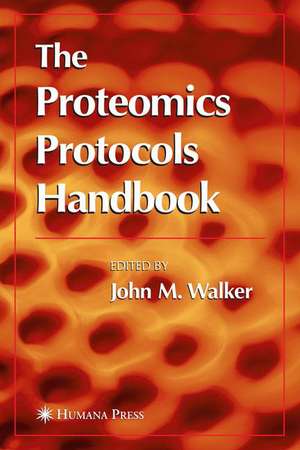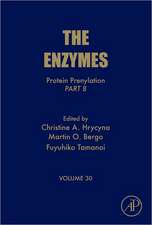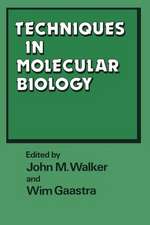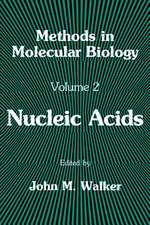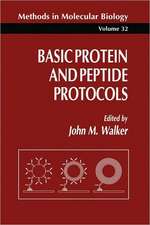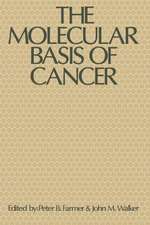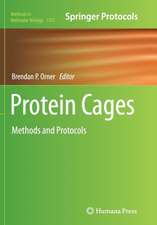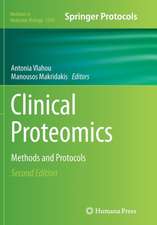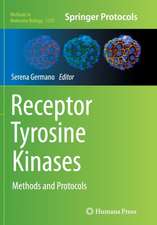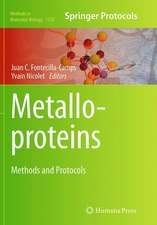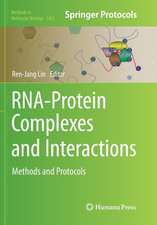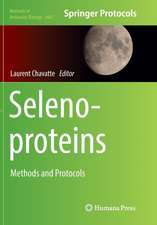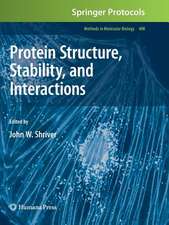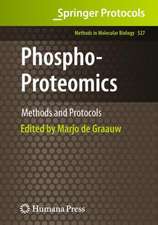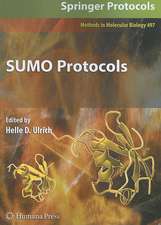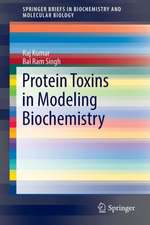The Proteomics Protocols Handbook
Editat de John M. Walkeren Limba Engleză Hardback – 9 mar 2005
| Toate formatele și edițiile | Preț | Express |
|---|---|---|
| Paperback (1) | 1855.11 lei 3-5 săpt. | |
| Humana Press Inc. – 9 mar 2005 | 1855.11 lei 3-5 săpt. | |
| Hardback (1) | 1866.14 lei 6-8 săpt. | |
| Humana Press Inc. – 9 mar 2005 | 1866.14 lei 6-8 săpt. |
Preț: 1866.14 lei
Preț vechi: 2275.78 lei
-18% Nou
Puncte Express: 2799
Preț estimativ în valută:
357.20€ • 388.13$ • 300.24£
357.20€ • 388.13$ • 300.24£
Carte tipărită la comandă
Livrare economică 21 aprilie-05 mai
Preluare comenzi: 021 569.72.76
Specificații
ISBN-13: 9781588293435
ISBN-10: 1588293432
Pagini: 1012
Ilustrații: XVIII, 988 p.
Dimensiuni: 178 x 254 x 59 mm
Greutate: 1.86 kg
Ediția:2005
Editura: Humana Press Inc.
Colecția Humana
Locul publicării:Totowa, NJ, United States
ISBN-10: 1588293432
Pagini: 1012
Ilustrații: XVIII, 988 p.
Dimensiuni: 178 x 254 x 59 mm
Greutate: 1.86 kg
Ediția:2005
Editura: Humana Press Inc.
Colecția Humana
Locul publicării:Totowa, NJ, United States
Public țintă
ResearchCuprins
Extraction and Solubilization of Proteins for Proteomic Studies Richard M. Leimgruber Preparation of Bacterial Samples for 2-D PAGE Brian Berg Vandahl, Gunna Christiansen, and Svend Birkelund Preparation of Yeast Samples for 2-D PAGE Joakim Norbeck Preparation of Mammalian Tissue Samples for Two-Dimensional Electrophoresis Frank A. Witzmann Differential Detergent Fractionation of Eukaryotic Cells Melinda L. Ramsby and Gregory S. Makowski Serum or Plasma Sample Preparation for Two-Dimensional Gel Electrophoresis Anthony G. Sullivan, Stephen Russell, Henry Brzeski, Richard I. Somiari, and Craig D. Shriver Preparation of Plant Protein Samples for 2-D PAGE David W. M. Leung Laser-Assisted Microdissection in Proteomic Analyses Darrell L. Ellsworth, Stephen Russell, Brenda Deyarmin, Anthony G. Sullivan, Henry Brzeski, Richard I. Somiari, and Craig D. Shriver Purification of Cellular and Organelle Populations by Fluorescence-Activated Cell Sorting for ProteomeAnalysis William L. Godfrey, Colette J. Rudd, Sujata Iyer, and Diether Recktenwald Purification of Nucleoli From Lymphoma Cells and Solubilization of Nucleolar Proteins for 2-DE Separation Régis Dieckmann, Yohann Couté, Denis Hochstrasser, Jean-Jacques Diaz, and Jean-Charles Sanchez Prefractionation of Complex Protein Mixture for 2-D PAGE Using Reversed-Phase Liquid Chromatography Volker Badock and Albrecht Otto Fractionation of Complex Proteomes by Microscale Solution Isoelectrofocusing Using ZOOM™ IEF Fractionators to Improve Protein Profiling Xun Zuo, Ki-Boom Lee, and David W. Speicher Large-Format 2-D Polyacrylamide Gel Electrophoresis Henry Brzeski, Stephen Russell, Anthony G. Sullivan, Richard I. Somiari, and Craig D. Shiver Analysis of Membrane Proteins by Two-Dimensional Gels MichaelFountoulakis 2-D PAGE of High-Molecular-Mass Proteins Masamichi Oh-Ishi and Tadakazu Maeda Using Ultra-Zoom Gels for High-Resolution Two-Dimensional Polyacrylamide Gel Electrophoresis Sjouke Hoving, Hans Voshol, and Jan van Oostrum NEpHGE and pI Strip Proteomic 2-D Gel Electrophoretic Mapping of Lipid-Rich Membranes Steven E. Pfeiffer, Yoshihide Yamaguchi, Cecilia B. Marta, Rashmi Bansal, and Christopher M. Taylor Silver Staining of 2-D Gels Julia Poland, Thierry Rabilloud, and Pranav Sinha Zn2+ Reverse Staining Technique Carlos Fernandez-Patron Multiplexed Proteomics Technology for the Fluorescence Detection of Glycoprotein Levels and Protein Expression Levels Using Pro-Q® Emerald and SYPRO® Ruby Dyes Birte Schulenberg and Wayne F. Patton Multiplexed Proteomics Technology for the Fluorescence Detection of Phosphorylation and Protein Expression Levels Using Pro-Q® Diamond and SYPRO® Ruby Dyes Birte Schulenberg, Terrie Goodman, Thomas H. Steinberg, and Wayne F. Patton Sensitive Quantitative Fluorescence Detection of Proteins in Gels Using SYPRO® Ruby Protein Gel Stain Birte Schulenberg, Nancy Ahnert, and Wayne F. Patton Rapid, Sensitive Detection of Proteins in Minigels With Fluorescent Dyes: Coomassie Fluor Orange, SYPRO® Orange, SYPRO Red, and SYPRO Tangerine Protein Gel Stains Thomas H. Steinberg, Courtenay R. Hart, and Wayne F. Patton Differential In-Gel Electrophoresis in a High-Throughput Environment Richard I. Somiari, Stephen Russell, Stella B. Somiari, Anthony G. Sullivan, Darrell L. Ellsworth, Henry Brzeski, and Craig D. Shriver Statistical Analysis of 2-D Gel Patterns Françoise Seillier-Moiseiwitsch 2-DE Databases on the World Wide Web Christine Hoogland, Khaled Mostaguir, and Ron D. Appel Computer Analysis of 2-D Images Patricia M. Palagi,
Textul de pe ultima copertă
Proteomics methodology has revolutionized the way that proteins are studied and opened new channels to understanding both cell functions and the cellular changes involved in disease states. In The Proteomics Protocols Handbook, hands-on researchers describe in step-by-step detail a wide range of proven laboratory methods and bioinformatics tools essential for analysis of the proteome. These cutting-edge techniques (73 in all) address such important tasks as sample preparation, 2D-PAGE, gel staining, mass spectrometry, and posttranslational modification. There are also readily reproducible methods for protein expression profiling, identifying protein-protein interactions, and protein chip technology, as well as a range of newly developed methodologies for determining the structure and function of a protein, including novel mass spectrometry and LC-MS techniques, protein array technology, and a variety of structural and functional proteomics techniques needed to determine of the function of newly discovered protein sequences. The use of X-ray crystallography and NMR to determine protein structure is also described. The bioinformatics tools include those for analyzing 2D-GEL patterns, protein modeling, and protein identification. All laboratory-based protocols follow the successful Methods in Molecular Biology™ series format, each offering step-by-step laboratory instructions, an introduction outlining the principle behind the technique, lists of the necessary equipment and reagents, and tips on troubleshooting and avoiding known pitfalls.
Timely and highly practical, The Proteomics Protocols Handbook offers molecular biologists, protein chemists, clinical and medicinal chemists, biochemists, and microbiologists a comprehensive collection of today's best tools for understanding not only the function of individual proteins in the cell, but also for identifying new therapeutic targets.
Timely and highly practical, The Proteomics Protocols Handbook offers molecular biologists, protein chemists, clinical and medicinal chemists, biochemists, and microbiologists a comprehensive collection of today's best tools for understanding not only the function of individual proteins in the cell, but also for identifying new therapeutic targets.
Caracteristici
Includes supplementary material: sn.pub/extras
